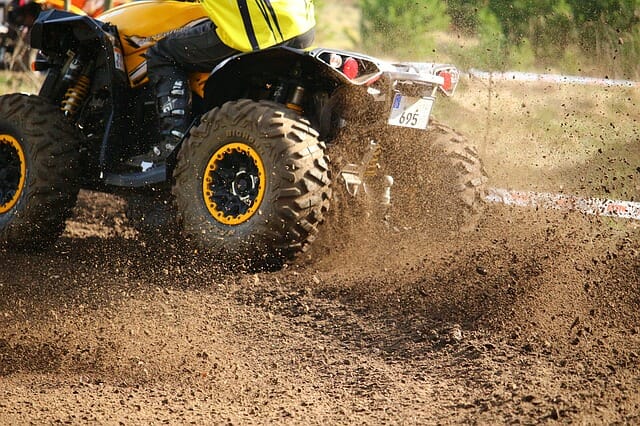Most riders love the adrenaline rush when they hit muddy trails and undulating landscapes with their all-terrain vehicles. However, if you are just getting started with these fascinating machines, you would be looking for some safety tips. In this post, we have come up with exactly the set of guidelines you need.
Firstly, you need to brush up on your skills and get yourself insured to take care of the damages or injuries if any. Besides, you need to prioritize off-road safety and follow driving etiquette.
The experts at Surex understand the requirements of their clients better than anyone else. Once you get yourself insured with the right coverage, you can confidently hit the trails!
Getting The Basics Right
Keep the following advisory points in mind when surfing through on your ATV:
1. Age Factor
Although you don’t need a driving license to steer these adventure machines, you must adhere to the age restrictions. Only people above 16 years of age can drive these vehicles.
Although no rigid norms govern the age, health experts recommend ATVs to kids aged above 16. This was determined after considering the necessary skills like speeding up, making fast adjustments, and weight-shifting. So, once you reach the age of 16, try to learn the basics.
2. Safety Certificate
You must get familiar with these machines. Before you hit the trail, practice driving in a controlled setting to master the art. In some states, teens above 16 should obtain a safety certificate before riding an ATV.
Otherwise, they would need adult supervision while on the machines. If you need details on some courses, feel free to skim through some of the institutes offering short courses in training teens.
3. Wear Safety Gear
The choice of proper safety gear happens to be one of the most important concerns. While you engage in adventure sports, it’s imperative to ensure optimal safety.
If you are a beginner, get a good helmet, as it is indispensable safety gear. The helmet should fit well, and there should be no rotation once you wear it. Try to fit your thumb between your forehead and the helmet. If the thumb fits this space, you need to cut down the size and get a smaller one.
Put on your seatbelt as you ride the vehicle. Use high-quality safety gear for ATV, including goggles, gloves, and boots.
4. Choose An ATV That Suits Your Age And Size
Beginners often set their hands on ATVs in their late teens. Considering that full-sized ATVs may weigh over 600 pounds, handling these machines might be an issue for them. Therefore, the ATV should be right in terms of size and complexity for the age group. Most manufacturers recommend the right age as far as the warning level on these vehicles is concerned.
5. Maintain Safe Speed
The tires of ATVs are not designed to withstand high speeds or pavement rides. Keep in mind that as you pick up speed, these machines might tip over as they become unstable. Therefore, you should maintain an average speed while you ride these vehicles.
6. Basic First Aid Knowledge
In case of minor injuries, you would need self-help. Health experts recommend teens driving ATVs to know the basics of first aid. When you engage in adventure sports, be prepared for injuries. With first aid knowledge, you would also be able to help your friends if they suffer an injury.
What Not To Do While Riding An ATV?
Regardless of the safety measures you undertake, you will rarely be completely safe. However, you can and should try to minimize the risk factors of accidents. Many people get injured due to their carelessness while they ride ATVs. The injuries may be severe and at times, may even get people killed. Therefore, beginners should adhere to the recommended safety measures when they ride ATVs. This would prevent accidents and injuries to others and themselves.
Here are certain actions you should refrain from:
• Do not ride ATVs with three wheels. They lack balance and make you more susceptible to accidents.
• Try not to ride ATVs during the night.
• Do not ride an ATV when you are under the impact of drugs or alcohol.
• In addition to public roads, do not ride the ATVs on any busy roads or paved surfaces.
• Do not exceed the number of recommended passengers, as given by the manufacturer.
• Even if you have a two-person all-terrain vehicle, never give rides to other passengers.
Additional Guidelines For Beginners Riding ATVs
The following guidelines are meant to educate beginner ATV riders:
1. No Distracted Driving
Try to focus only on your ride when you’re on the ATV. Do not use your mobile phone while riding these machines, as they are likely to distract you. Distraction would prove harmful to other passengers as well. Additionally, do not drive under the influence of alcohol or drugs.
2. Know Your Provincial Regulations And Laws
Depending on your location in Canada, the provincial norms regulating ATV guidelines may vary. It’s recommended you have adequate knowledge of these norms to be on the safe side. Go through the official website of Transport Canada to thoroughly understand these norms.
3. Get Yourself Insured
You need adequate insurance for yourself to manage the expenses resulting from injuries. Any type of adventure sport exposes you to the risk of hurting yourself. Speak to the experts to know the most comprehensive coverages at economical rates. This will ensure that you get timely medical attention. Also, you won’t be draining off your resources to manage your medical expenses.
4. Learn How To Ride
Being aware of courses offering training on how to ride ATVs will always come in handy. Similar to how you gained mastery in driving your car, you should master the art of controlling these robust machines as well.
The Canada Safety Council has fully certified courses for beginners. You can also undergo training online for a certain part of the program. In these courses for beginners, you will learn about navigating through terrains, ATV controls, climbing hills, and turning vehicles.
Endnote
Riding ATVs over challenging terrains might seem to be an exciting pursuit. However, try not to ride alone. Instead, be a part of groups when you engage in these activities. The group leader should know the trail properly. Besides, the last rider should have adequate experience as well.
Nonetheless, it pays to get yourself sufficiently insured when you engage in adventure sports. Consider reaching out to a professional specialist to know the most cost-effective packages you can avail of.




